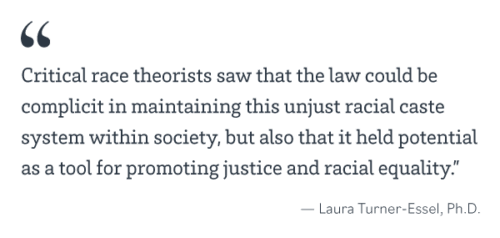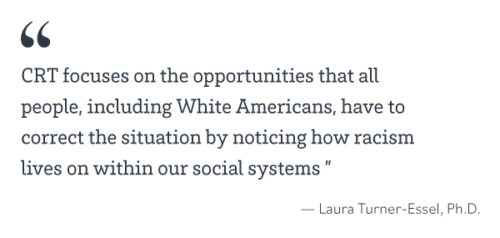Critical Race Theory. Three simple words, and yet their mere utterance in succession strikes fear in the hearts of a significant chunk of the American population. But what is it about this academic concept that has drawn such ire in the wake of renewed calls for racial justice across the United States? Rather than being the reductive boogeyman detractors describe, Critical Race Theory (CRT) has been vastly misrepresented in national conversations.
In a point/counterpoint piece published by The Gazette, a newspaper based in Colorado Springs, Nathaniel Granger, Psy.D., and adjunct faculty in Saybrook University’s Department of Humanistic and Clinical Psychology, argued in favor of teaching Critical Race Theory in Colorado Schools. According to him, “It is crucial to understand CRT prior to entertaining and/or establishing policies against or in support of it.” However, many who use the term do not understand it.
It seems that many of the recent discussions surrounding CRT have focused on fears and misconceptions about the theory rather than what the theory is and why it was created. However, in order to have open and productive discussions, it’s vital to come to a mutual understanding of what CRT actually is and what the intentions were behind creating it.

What is Critical Race Theory?
Critical Race Theory, commonly abbreviated as CRT, was created in the 1970s and 1980s by legal scholars including Richard Delgado, the late Derrick Bell, and Kimberlé Crenshaw—the latter of whom coined the term. The theory grew from the field of Critical Legal Studies, a field that was considered radical at the time according to Laura Turner-Essel, Ph.D. and adjunct faculty in the Department of Transformative Social Change at Saybrook. “It argued that the law was not objective, neutral or apolitical, contrary to the common perception within the legal studies field at the time,” Dr. Turner-Essel explains.

The intent behind the theory was to examine racist systems that persist within the make up of law enforcement and criminal justice in the U.S. Despite the passing of the Civil Rights Act in 1968 and desegregation efforts since, these types of systems continue to disproportionately affect marginalized groups in the United States, especially Black Americans.
“Critical race theorists saw that the law could be complicit in maintaining this unjust racial caste system within society, but also that it held potential as a tool for promoting justice and racial equality,” Dr. Turner-Essel says. “They wanted to show how the concept of race and the realities of racism had been encoded into the laws and institutions of the nation and were continuing to reproduce racial disparities in almost every aspect of life.”
When created, CRT was intended to address the role of racism in the law and to work to eliminate it. However, the term has since caught on outside the field of law, and there has been a great deal of discrepancy in the way it has been portrayed in media and public discourse ever since.

Confronting Misconceptions
Discrepancies in the perception and reception of CRT seem to begin with misunderstandings of the intent behind the theory, in addition to fundamental differences of perception regarding the current reality black people are living in.
According to a recent article from Politifact, “Supporters describe critical race theory as a collection of ideas, not a single doctrine, that explain why racial inequality and disparities persist long after civil rights laws and court rulings barred discrimination.” This view aligns with the intent behind the theory as indicated by its creators. Alternately, Politifact says, “opponents use it as a blanket label for any discussion of white privilege, and they have encouraged local school districts to forbid the teaching of anything that addresses systemic racism.”
Additionally, though K-12 schools across the U.S. have been accused of implementing CRT into curricula, it is not a K-12 concept. It was created specifically for law school circles in higher education. However, anti-racist and anti-bias initiatives for K-12 educational environments have been implemented in some schools nationwide, prompting critics to conflate them with CRT due to overlap in objectives.

Detractors present CRT as a static concept, permanently casting white Americans as racist oppressors and Black Americans as victims. However, CRT is not so constrictive. As Dr. Turner-Essel explains, “Psychologically, I understand how being affiliated with a group that has enacted harms could induce an emotional response. However, CRT focuses on the opportunities that all people, including White Americans, have to correct the situation by noticing how racism lives on within our social systems (whether or not any one person in that system appears to be a “racist”) and to actively change those systems to stop harming people of color.”
Changing harmful racist systems requires open and honest acknowledgement that they exist in the first place. CRT opts to meet the truths of persistent racial inequality in the United States head-on, rather than shying away from them. However, demands for change are directed at systems, rather than individuals. “CRT recognizes that racism is indeed foundational to many of our societal institutions, not just a periodic malfunction, and focuses on ways that we can collectively change structures,” Dr. Turner-Essel says. “It does not focus on making individuals feel like ‘bad people’ for being a certain race.”
In his piece for The Gazette, Dr. Granger contends that CRT’s aim of striving for equality transcends the Black vs. white racial binary to recognize the impact racism has had on experiences of various people of color, including Latinx individuals, Native Americans, and Asian Americans. “CRT challenges white privilege, a primary factor for its resistance, and exposes deficit-informed research that ignores, and often omits, the scholarship of people of color,” Dr. Granger writes. “Contrary to what is often stated, CRT does not suggest any ‘racial’ group is inherently inferior or biased, which would contradict the foundational premise that race is a social construction.”
Ultimately the social construction of race must be recognized as such: a human concept influenced by culture and socialization, rather than an inherent biological set of characteristics.

Why we need Critical Race Theory
As Dr. Granger states in The Gazette, “We are disillusioned if we believe or act as if racism has had no part in the shaping of America.”
If anything, the evidence of persistent systemic racism has been thrust into the spotlight more than ever over the past few years due to various widely publicized acts of violence and injustice against Black Americans, including many perpetrated by law enforcement officers.
Black Americans account for 13.4% of the population in the U.S., the third largest racial group in the country after Hispanic or Latino at 18.5% and white at 76.3%. However, the rates of arrest, conviction, and incarceration for Black Americans are disproportionately higher than those of larger racial groups.
A recent report found that black men and boys face the highest lifetime risk of being killed by police among all groups, and incarceration rates reveal a similar discrepancy. Even with results demonstrating an overall decline in incarceration for all people as recently as 2020, “Black Americans remain far more likely than their Hispanic and white counterparts to be in prison. The black imprisonment rate at the end of 2018 was nearly twice the rate among Hispanics (797 per 100,000) and more than five times the rate among whites (268 per 100,000),” according to Pew Research.
Science has reaffirmed time and again that race is a social construct, not a biological attribute, meaning the continuation of high racial inequity is not due to any factors inherently found within the biological make up of humans. Many have gravitated toward CRT to get a better understanding of the nature of the issue. Dr. Turner-Essel notes, “As with any theoretical perspective, CRT’s value is in its ability to explain the realities we observe. But CRT also expands our understanding by including the perspectives, scholarship, and lived experiences of people of color in its analysis, rather than only viewing people of color as being full of deficits and problems.”
Only with critical analysis of systems can meaningful structural changes begin. However, the key to this type of systemic analysis is for it to remain honest. CRT conversations might not always be comfortable for everyone involved, but they’re necessary to break down misconceptions and move forward. As Dr. Granger stated in The Gazette, “To raise the question of if CRT should be taught in our schools is asking if the truth of America should be taught to those who hold our future, or should they be bamboozled with distorted information, such as being taught that Christopher Columbus ‘discovered’ America.”

Moving Forward
In the couple of years since CRT exploded onto the scene as the latest buzzword, criticisms have continued to grow, and school boards across the U.S. face attacks on any CRT-related policies. Additionally, many of the same CRT detractors have begun misrepresenting other modern educational initiatives and associating them with CRT, including Social-Emotional Learning.
Dr. Turner-Essel points out the importance of continuing to challenge misinformation. “We must clarify terms by referring people to the work of reputable scholars who have dedicated their careers to this approach,” she says. “Everyone need not adopt the CRT perspective, but it is important for the sake of intellectual integrity to accurately represent what CRT says and what it does not.”
It is vital to keep pushing back against lies with the truth. Fortunately, many academic programs, including Saybrook’s Transformative Social Change program, are preparing aspiring agents of change to meet the challenge. Though CRT itself is not taught at Saybrook due to its nature as a law school concept, its systemic perspective and progressive approach aligns with Saybrook’s core mission and values.
“The program in Transformative Social Change aims to help students understand, at a very deep level, the systemic and interconnected nature of societal problems and to use this awareness to implement positive remedies,” Dr. Turner-Essel says.

Learn more about Saybrook University
If you are interested in learning more about the community and academic programs at Saybrook University, fill out the form below to request more information. You can also apply today through our application portal.
Find Out More
Recent Posts































